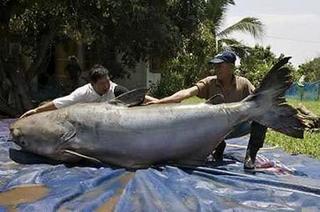Fresh Fish!
No Fish Tale: Thais Catch 646-Pound Fish
By DANIEL LOVERING, Associated Press Writer
BANGKOK, Thailand - This big one did not get away. Thai fishermen netted a 646-pound catfish believed to have been the world's largest freshwater fish ever caught in Thailand, a researcher said Thursday.

The nearly 9-foot-long Mekong giant catfish was landed May 1 by villagers in Chiang Khong, a remote district in northern Thailand, and weighed by Thai fisheries department officials, said Zeb Hogan, who leads an international project to locate and study the world's largest freshwater fish species.
He confirmed it was the heaviest fish on record since Thailand started keeping such statistics in 1981.
The fishermen had hoped to sell the fish to environmental groups, which planned to release it to spawn upriver, but it died before it could be handed over and then was chopped up and sold in pieces to villagers as food.
Hogan, whose work is funded by the World Wildlife Fund and the National Geographic Society, said he is planning to write a paper about the catch for a scientific journal.
"That's the best way to document this kind of thing," he told The Associated Press by telephone.
The Mekong giant catfish was listed as critically endangered in 2003 after research showed its numbers had fallen by at least 80 percent in the past 13 years.
Fishermen believe the catfish species has been declining largely because of dams and environmental damage along the Mekong River — home to more species of giant fish than any other river, said an earlier statement by WWF and the society.
Read more!
By DANIEL LOVERING, Associated Press Writer
BANGKOK, Thailand - This big one did not get away. Thai fishermen netted a 646-pound catfish believed to have been the world's largest freshwater fish ever caught in Thailand, a researcher said Thursday.

The nearly 9-foot-long Mekong giant catfish was landed May 1 by villagers in Chiang Khong, a remote district in northern Thailand, and weighed by Thai fisheries department officials, said Zeb Hogan, who leads an international project to locate and study the world's largest freshwater fish species.
He confirmed it was the heaviest fish on record since Thailand started keeping such statistics in 1981.
The fishermen had hoped to sell the fish to environmental groups, which planned to release it to spawn upriver, but it died before it could be handed over and then was chopped up and sold in pieces to villagers as food.
Hogan, whose work is funded by the World Wildlife Fund and the National Geographic Society, said he is planning to write a paper about the catch for a scientific journal.
"That's the best way to document this kind of thing," he told The Associated Press by telephone.
The Mekong giant catfish was listed as critically endangered in 2003 after research showed its numbers had fallen by at least 80 percent in the past 13 years.
Fishermen believe the catfish species has been declining largely because of dams and environmental damage along the Mekong River — home to more species of giant fish than any other river, said an earlier statement by WWF and the society.
Read more!

